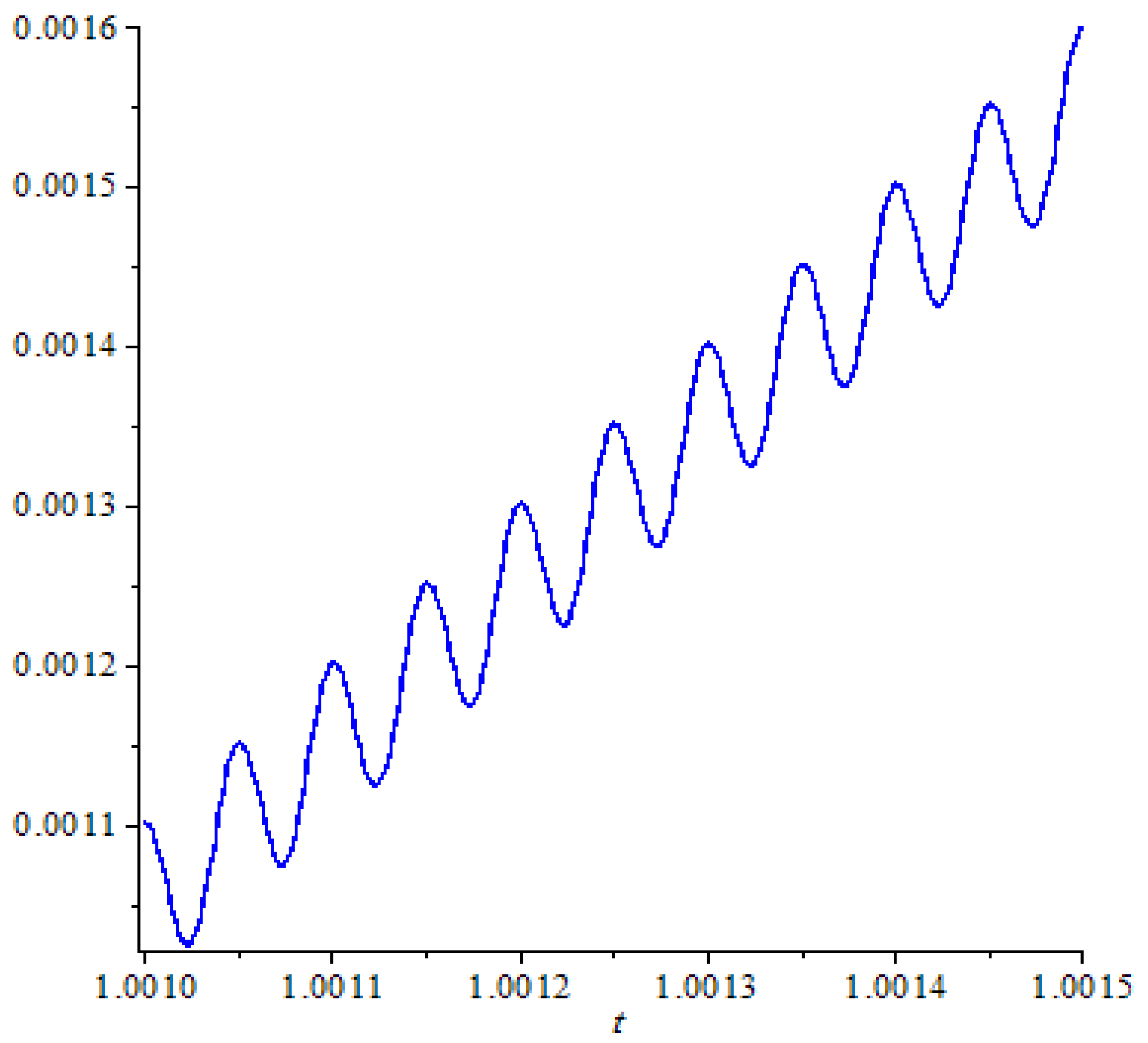Oscillation Criteria for First Order Differential Equations with Non-Monotone Delays
Abstract
1. Introduction
2. Main Results
- (i)
- ,
- (ii)
- ,
Author Contributions
Funding
Acknowledgments
Conflicts of Interest
References
- Agarwal, R.P.; Berezansky, L.; Braverman, E.; Domoshnitsky, A. Non-Oscillation Theory of Functional Differential Equations with Applications; Springer: New York, NY, USA; Dordrecht, The Netherlands; Heidelberg, Germany; London, UK, 2012. [Google Scholar]
- Braverman, E.; Karpuz, B. On oscillation of differential and difference equations with non-monotone delays. Appl. Math. Comput. 2011, 218, 3880–3887. [Google Scholar] [CrossRef]
- El-Morshedy, H.A. On the distribution of zeros of solutions of first order delay differential equations. Nonlinear Anal. 2011, 74, 3353–3362. [Google Scholar] [CrossRef]
- El-Morshedy, H.A.; Attia, E.R. New oscillation criterion for delay differential equations with non-monotone arguments. Appl. Math. Lett. 2016, 54, 54–59. [Google Scholar] [CrossRef]
- Erbe, L.H.; Kong, Q.; Zhang, B.G. Oscillation Theory for Functional Differential Equations; Dekker: New York, NY, USA, 1995. [Google Scholar]
- Gopalsamy, K. Stability and Oscillations in Delay Differential Equations of Population Dynamics; Kluwer Academic Publishers: Dordrecht, The Netherlands, 1992. [Google Scholar]
- Gyori, I.; Ladas, G. Oscillation Theory of Delay Differential Equations with Applications; Clarendon Press: Oxford, UK, 1991. [Google Scholar]
- Jaroš, J.; Stavroulakis, I.P. Oscillation tests for delay equations. Rocky Mt. J. Math. 1999, 29, 197–207. [Google Scholar] [CrossRef]
- Kon, M.; Sficas, Y.G.; Stavroulakis, I.P. Oscillation criteria for delay equations. Proc. Am. Math. Soc. 2000, 128, 2989–2997. [Google Scholar] [CrossRef]
- Koplatadze, R.G.; Chanturija, T.A. On oscillatory and monotonic solutions of first order differential equations with deviating arguments. Differential’nye Uravnenija 1982, 18, 1463–1465. (In Russian) [Google Scholar]
- Koplatadze, R.G.; Kvinikadze, G. On the oscillation of solutions of first order delay differential inequalities and equations. Georgian Math. J. 1994, 1, 675–685. [Google Scholar] [CrossRef][Green Version]
- Ladas, G. Sharp conditions for oscillations caused by delays. Appl. Anal. 1979, 9, 93–98. [Google Scholar] [CrossRef]
- Ladas, G.; Lakshmikantham, V.; Papadakis, L.S. Oscillations of Higher-Order Retarded Differential Equations Generated by the Retarded Arguments, in Delay and Functional Differential Equations and Their Applications; Academic Press: New York, NY, USA, 1972. [Google Scholar]
- Myshkis, A.D. Linear homogeneous differential equations of first order with deviating arguments. Uspekhi Mat. Nauk 1950, 5, 160–162. (In Russian) [Google Scholar]
- Philos, C.G.; Sficas, Y.G. An oscillation criterion for first-order linear delay differential equations. Canad. Math. Bull. 1998, 41, 207–213. [Google Scholar] [CrossRef]
- Sficas, Y.G.; Stavroulakis, I.P. Oscillation criteria for first-order delay equations. Bull. London Math. Soc. 2003, 35, 239–246. [Google Scholar] [CrossRef]
- Stavroulakis, I.P. Oscillation criteria for delay and difference equations with non-monotone arguments. Appl. Math. Comput. 2014, 226, 661–672. [Google Scholar] [CrossRef]
- Bereketoglu, H.; Karakoc, F.; Oztepe, G.S.; Stavroulakis, I.P. Oscillation of first order differential equations with several non-monotone retarded arguments. Georgian Math. J. 2019. [Google Scholar] [CrossRef]
- Infante, G.; Koplatadze, R.; Stavroulakis, I.P. Oscillation criteria for differential equations with several retarded arguments. Funkcial. Ekvac. 2015, 58, 347–364. [Google Scholar] [CrossRef]

© 2020 by the authors. Licensee MDPI, Basel, Switzerland. This article is an open access article distributed under the terms and conditions of the Creative Commons Attribution (CC BY) license (http://creativecommons.org/licenses/by/4.0/).
Share and Cite
Attia, E.R.; El-Morshedy, H.A.; Stavroulakis, I.P. Oscillation Criteria for First Order Differential Equations with Non-Monotone Delays. Symmetry 2020, 12, 718. https://doi.org/10.3390/sym12050718
Attia ER, El-Morshedy HA, Stavroulakis IP. Oscillation Criteria for First Order Differential Equations with Non-Monotone Delays. Symmetry. 2020; 12(5):718. https://doi.org/10.3390/sym12050718
Chicago/Turabian StyleAttia, Emad R., Hassan A. El-Morshedy, and Ioannis P. Stavroulakis. 2020. "Oscillation Criteria for First Order Differential Equations with Non-Monotone Delays" Symmetry 12, no. 5: 718. https://doi.org/10.3390/sym12050718
APA StyleAttia, E. R., El-Morshedy, H. A., & Stavroulakis, I. P. (2020). Oscillation Criteria for First Order Differential Equations with Non-Monotone Delays. Symmetry, 12(5), 718. https://doi.org/10.3390/sym12050718





